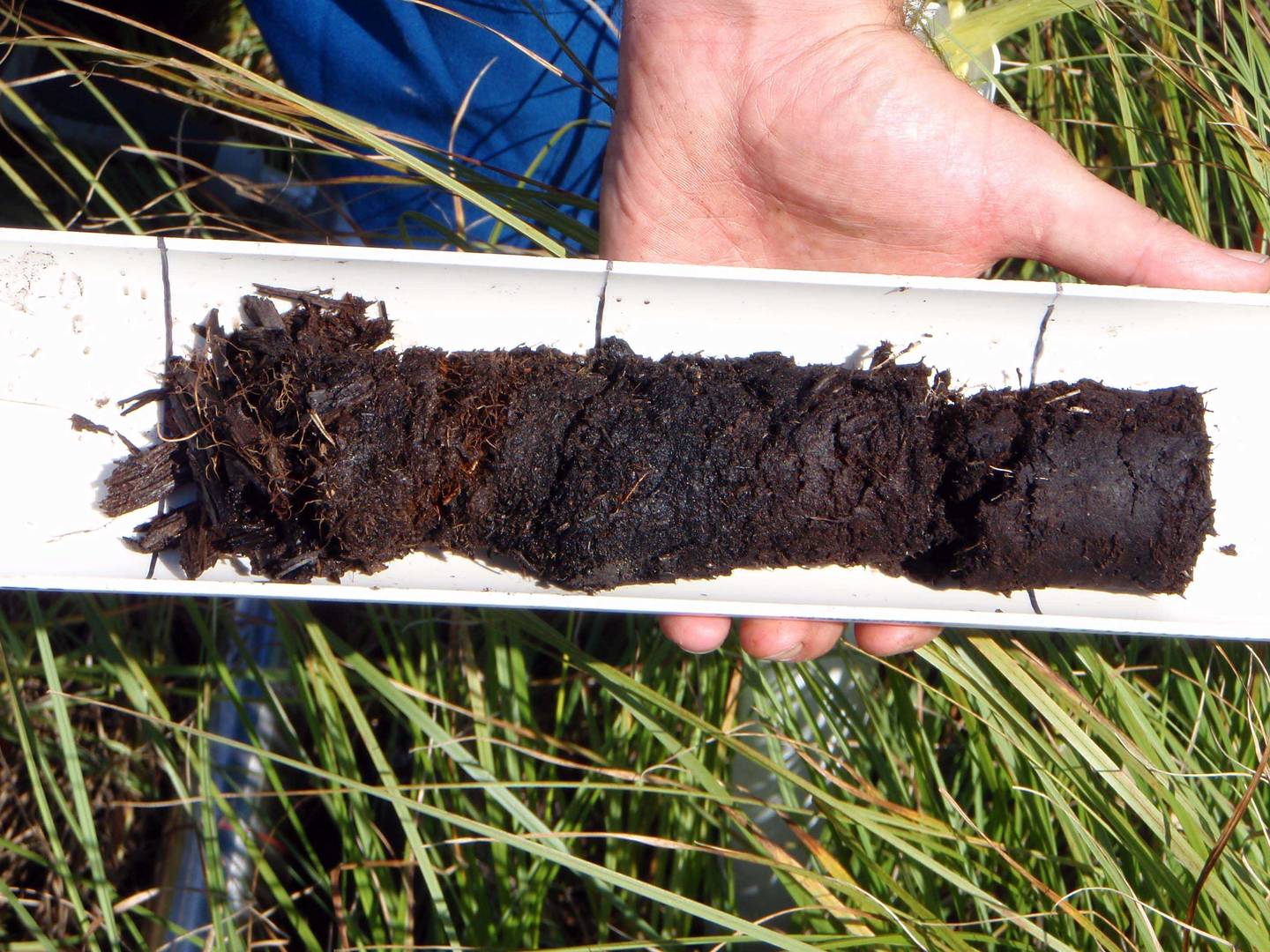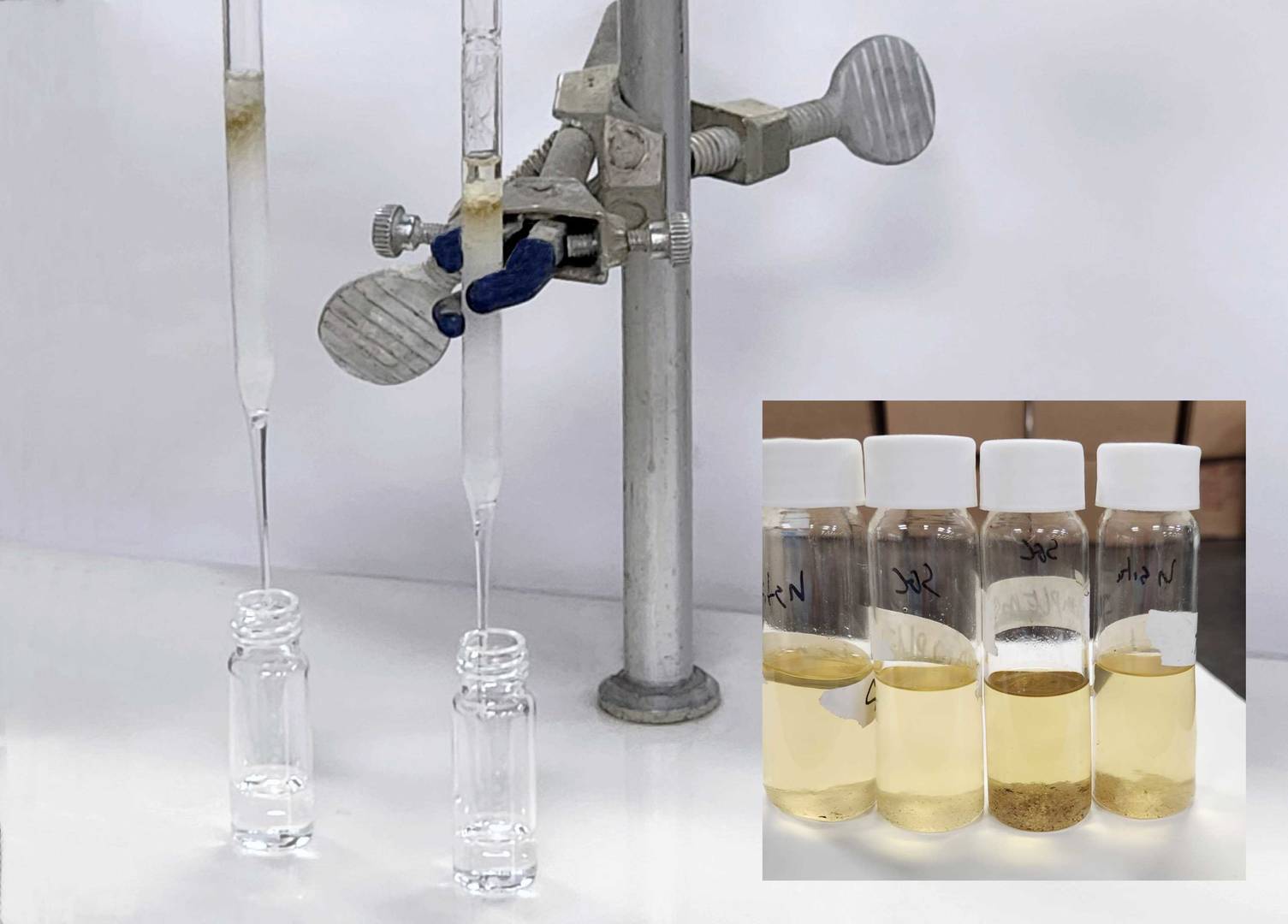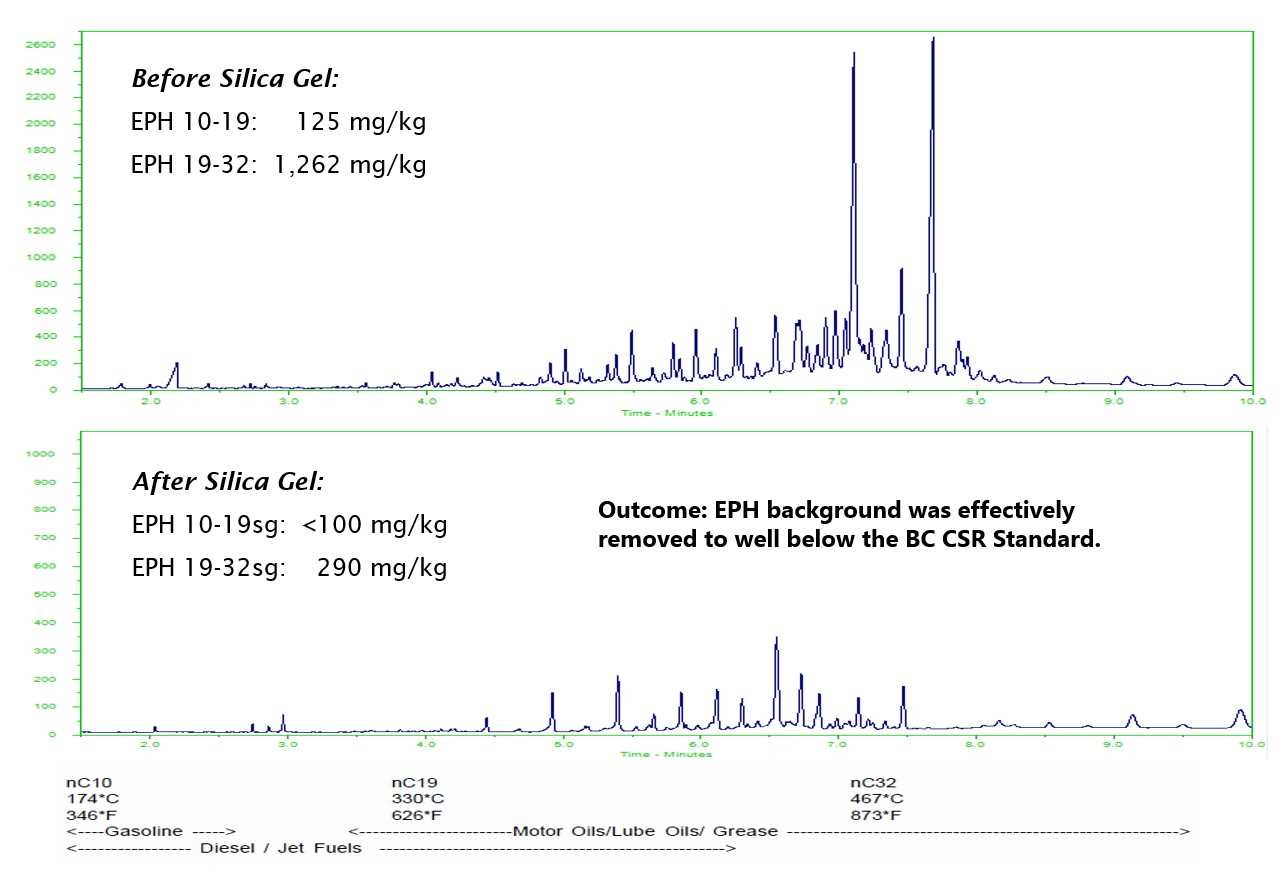EnviroMail 52 Canada - Addressing False Petroleum Hydrocarbon Detections from Natural Organics
Wood waste, manure, and organic soils such as peat or compost are all well-known causes of false positive interferences for common petroleum hydrocarbon (PHC) tests, due to the presence of detectable biogenic organic compounds.

Silica gel cleanup can remove most biogenic interferences based on polarity differences between natural organics and PHCs, with different types of cleanups having varying degrees of effectiveness. An alternative empirical model known as the Biogenic Interference Calculation can also be applied under some circumstances to identify false exceedances of the CCME F3 soil standards.
PHC False Positives due to Natural Substances
Most test methods for Petroleum Hydrocarbons are non-selective because they must capture thousands of different substances found within complex PHC mixtures. Testing of soils or waters for PHCs usually involves an extraction with organic solvent, where the resulting extract is analyzed by Gas Chromatography with Flame Ionization Detection (GC-FID). A GC-FID separates complex mixtures by boiling point, using an inert gas flowing through a narrow column coated with a film of stationary phase. GC-FID PHC methods respond to any combustible substance that elutes from the GC within the targeted boiling point fraction, based on elution times of n-alkane marker compounds. The most common Canadian extractable PHC tests span from nC10 to nC32 for BC & RBCA EPH, or from nC10 to nC50 for CCME F2-F4.
Unfortunately, many non-PHC substances are also detected by GC-FID hydrocarbon test methods, where they are extractable and semi-volatile (within targeted ranges). These interferences include many substances found in plant materials and organic soils, such as plant waxes (alkanes), fatty acids, fatty alcohols, sterols, and sterones. Peat soils are very common in muskeg or peatland ecosystems in many regions of Canada, and frequently exceed the most stringent provincial regulatory standards for PHCs solely due to interferences from biogenic substances. Wood waste, compost, and manure-treated soils can also cause significant false positives for PHCs. Fragrant plant materials such as Labrador Tea (commonly found in Canadian wetlands), pine or cedar needles, and fresh wood chips can also cause PHC interferences with very unique chromatographic profiles.
Minimizing PHC False Positives with Silica Gel Cleanups
Silica gel cleanup is the industry-standard technique to reduce interferences on PHC tests due to natural organics. Silica gel is an amorphous (non-crystalline) form of silica (SiO2). Silica gel cleanups are based on the principle that most petroleum hydrocarbons are non-polar, whereas most biogenic interfering substances are polar (typically oxygenated). Silica is a very polar molecule which tends to bind to other polar substances, causing them to be physically removed from PHC solvent extracts, while non-polar petroleum hydrocarbons are left untouched.

Fig 1. Peat soil averages 40-50% organic carbon
In-Situ versus Column Silica Gel Cleanups
Two types of silica gel cleanups are common. The simplest is the “in-situ” or dispersive cleanup, where silica gel adsorbent is added directly to a sample extract prior to analysis. Column-based silica gel cleanups are more complex, but are more effective at removing some types of interferences. In a column cleanup, a sample extract is passed slowly through a vertical column of silica gel, which gives more potential for interaction with fresh, active silica gel than with an in-situ cleanup. ALS offers a standard in-situ silica gel cleanup (for CCME and RBCA tests) as well as a column-based silica gel cleanup that has been specifically optimized for maximum effectiveness with peat or muskeg soils, which provides the best possible removal of natural biogenic substances for PHC tests. The ALS column cleanup also includes an extract concentration procedure that helps to prevent increased detection limits due to the high moisture content of most organic soils.

Fig 2. BC EPH silica gel column cleanup (background peat soil)
Silica Gel Applications by Test Method
Silica gel cleanups can be used for any extractable PHC GC-FID test, but regional test methods have different requirements. The CCME F2-F4 Soil PHC method includes an in-situ silica gel cleanup by default, but a column-based cleanup may optionally be used where optimal cleanup effectiveness is needed. The BC and RBCA EPH methods both allow optional silica gel cleanups for samples where significant biogenic interferences are expected. Please refer to Table 1 for applicable ALS Canada silica gel test codes and options for the most common Canadian PHC tests.
Silica gel cleanups for PHCs are primarily intended for use with organic soils, because interferences from biogenic organic matter in such samples are common and expected. Silica gel cleanup may also be beneficial for PHC testing of some water samples, such as for groundwaters in wetlands. Silica gel can also remove some non-biogenic polar interferences on PHC water sample tests, such as surfactants found in some cleaning products.
Table 1. Silica Gel Cleanup Information by Test Method
| PHC Test | Parameters | Test Codes | Silica Gel (SG) Usage |
| CCME F2-F4 |
F2 (C10-C16) F3 (C16-C34) F4 (C34-C50) |
E601.CSG | In-situ SG cleanup is included with default F2-F4 method. SG column cleanup recommended for organic soils to address potential regulatory exceedances. |
| BC EPH & LEPH/ HEPH |
EPH10-19 / LEPH EPH19-32 / HEPH |
E601A.SG | SG column cleanup may be used if biogenic interferences anticipated. Usage must be noted on reports. |
| RBCA EPH |
EPH >C10-C16 EPH >C16-C21 EPH >C21-C32 |
E601G.SG E601G.CSG |
SG cleanup may be used (in-situ or column) if biogenic interferences anticipated. Usage must be noted on reports. |
What to Expect from Silica Gel Cleanups
For uncontaminated soil samples containing significant levels of biogenic organics, column-based silica gel cleanups often reduce detected results by ~50-75%, particularly in the CCME F3 range (C16-C34), or the BC EPH 19-32 (HEPH) range, or the RBCA EPH >C16-C21 range. Silica gel cannot remove non-polar biogenic interferences such as plant waxes, which are typically seen as odd-numbered n-alkanes (~nC25-nC35). Refer to Figure 3 and Table 2 for examples of silica gel cleanup effectiveness for background peat soils by EPH and CCME methods. Most unweathered petroleum hydrocarbon substances, including PAHs, are not affected by silica gel.
Table 2. CCME In-situ vs. silica gel column cleanup (background peat)
| Background Peat Soil Results | F2 (C10-16) mg/kg | F3 (C16-34) mg/kg | F4 (C34-50) mg/kg |
| In-situ silica gel cleanup | 36 | 539 | 320 |
| silica gel column cleanup | 27 | 311 | 161 |
| silica gel column cleanup vs in-situ | ~equal | 42% less | 50% less |

Fig 3. BC EPH silica gel column cleanup (background peat soil)
Biogenic Interference Calculation (BIC)
In cases where silica gel cleanup is insufficient to address interferences, an empirical evaluation scheme using the Biogenic Interference Calculation (BIC Scale) may be used to identify where biogenic organic compounds are causing false exceedances of CCME F3 soil quality standards. This approach has been endorsed for regulatory applications in Alberta, but may potentially be applied in any province to explain false exceedances of regulatory standards due to biogenic interferences. The model is derived from empirical observations and measurements from dozens of contaminated and uncontaminated peat, compost, and manure samples. A primary premise of the model is that for uncontaminated organic soils, the F3B (C22-34) subfraction constitutes > 85% of the total F3 fraction (C16-34). Another important premise is that uncontaminated organic soils do not normally contribute significant interferences within the F2 (C10-16) fraction.
To apply this model, soil samples must be tested for CCME PHC sub-fractions F3A (C16-22) and F3B (C22-34) using the standard in-situ silica gel cleanup, and must also be tested for TOC to confirm organic soil type. All of the criteria shown in Table 3 should then be evaluated. The BIC value is calculated as shown below (F2 non-detects are treated as one-half the detection limit). When considered together with all other BIC model criteria, BIC values ≤ 10% indicate false exceedances of F3 standards. The BIC model is only approved for use with PHC source materials with contaminants in the F2 fraction (e.g. gasoline, diesel, crude oil). ALS can provide a full evaluation of BIC model criteria, including the requirement for review of GC-FID chromatograms by a qualified person to confirm absence of Unresolved Complex Mixtures (UCMs) that may indicate PHC contaminants.
Table 3. Summary of BIC Model Criteria & Rationale
| BIC Model Criteria | Rationale / Requirement |
| F2 < 30 mg/kg | F2 (C10-16) detections usually indicate PHCs |
| F3B / F3 > 85% | empirical relationship for uncontaminated peat soils |
| TOC > 17% | confirms organic soil type |
| BIC ≤ 10% | empirical relationship for uncontaminated peat soils |
| Confirm no UCM | chromatogram evaluation by qualified person |
| Spill type restriction | only for use with PHC source materials containing F2 (gasoline, diesel, crude oil, etc.) |
 |
|
Please contact your ALS Project Manager to request PHC tests with optional silica gel cleanups or qualitative chromatogram evaluations in cases where you suspect interferences on PHC tests due to biogenic substances.
Reference:























































